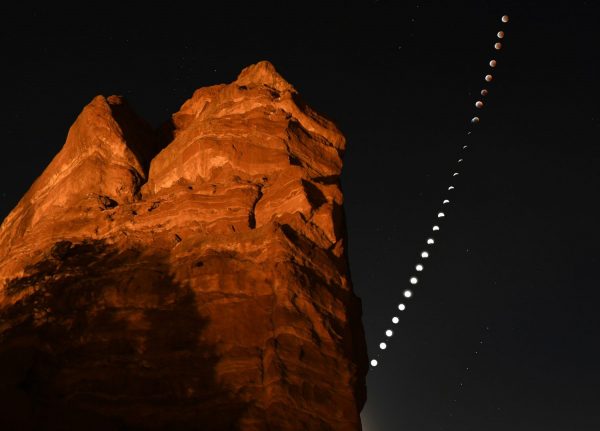Astronomy 2020: Every major meteor shower, supermoon and more – The Know

This weekend could offer one of the best celestial events of 2020 when the Quadrantids meteor shower reaches its peak, assuming the weather cooperates.
That’s just one of the nighttime shows for stargazers to note on their calendars this year. There also will be some fun things to watch regarding the planet Mars in February and October, a special full moon in April and the “super conjunction” of Jupiter and Saturn in December, when the two largest planets in the solar system appear to come together. That also will coincide with the Winter Solstice.
Here are eight astronomical events to watch for this year:
Quadrantids meteor shower, Jan. 4
According to the International Meteor Organization, the Quadrantids have the potential to be the strongest meteor shower of the year, and they are peaking this weekend. “The average hourly rates one can expect under dark skies is 25,” the IMO says. “These meteors usually lack persistent trains (vaporized rock that glows after the meteor burns up in the atmosphere) but often produce bright fireballs.”
Moon passes in front of Mars, Feb. 18
Get out your binoculars — or a telescope if you have one — for Feb. 18, when the moon will pass in front of the planet Mars in an event called an occultation. “The moon will glide in front of reddish, star-like Mars for viewers across North America, Central America, extreme northern South America, Cuba and Haiti,” according to Space.com. A couple of hours later, Mars will show up on the other side of the moon (as seen from Earth). The moon will appear 23% full on that night.
Venus puts on a show, March 24-June 3
This one comes recommended by John Keller, director of the Fiske Planetarium at the University of Colorado.
“Venus will be high in the evening sky in April and pass very close to the Pleiades star cluster, an easy naked-eye target,” said Keller, adding that the Pleiades star cluster is easy to spot because it looks like the stars in the Subaru logo. “Venus will be highest in the evening sky on March 24, passing by the Pleiades April 2 and April 3. Also of potential interest, Venus will then dive down towards the sun during the month of May and re-emerge in the morning sky in mid-June after passing by the sun on June 3. The waning crescent moon will pass very close by Venus on June 19 and provide a nice guide for observers looking for their first view of Venus in the morning sky.”
Supermoon, April 7
The moon will be full when its orbit takes it closest to the Earth (called perigee) for the year at 221,772 miles. The moon has an elliptical orbit, and its average distance from Earth is 238,855 miles. Its apogee (farthest distance) is 252,088 miles. Because there is no consensus on what constitutes a supermoon — it’s a matter of how close the moon is to the earth — there will be one, two or three other supermoons this year (February, March and May). There also will be a second full moon in October, a so-called “blue moon,” and it will occur on Halloween.
Perseids meteor shower, July 17-Aug. 26
This will be another highlight of the year for meteor lovers. Peaking Aug. 11-12, the Perseids are the most popular meteor shower in North America.
“Normal rates seen from rural locations range from 50-75 shower members per hour at maximum,” the International Meteor Organization reports. “The Perseids are particles released from comet 109P/Swift-Tuttle during its numerous returns to the inner solar system. They are called Perseids since the radiant (the area of the sky where the meteors seem to originate) is located near the prominent constellation of Perseus the hero when at maximum activity.”
The moon will be about half-full when the Perseids peak this year.
Martian glory, Sept. 29-Oct. 28
According to Space.com, Mars will be “spectacular” in October. Because of its proximity to Earth, Mars will appear brighter than Jupiter and will be the third-brightest object in the nighttime sky, after the moon and Venus. On Oct. 6, Mars will be only 38.6 million miles from Earth. It won’t be that close again until 2035.
Geminids meteor shower, Dec. 4-17
According to the IMO, the Geminids meteor shower is usually the strongest of the year, and this year we get a bonus: There will be no moonlight to obscure the view when the Geminids peak Dec. 13-14. Fans of meteor showers may recall that the Geminid peak in 2019 coincided with a nearly full moon.
“The Geminids are often bright and intensely colored,” the IMO says. “Due to their medium-slow velocity, persistent trains are not usually seen.”
“Conjunction” of Jupiter and Saturn, Dec. 21
A conjunction occurs when two planets come closest together on their individual orbits. Conjunctions for these two planets occur approximately every 20 years. On the Winter Solstice this year, Jupiter and Saturn will be the closest they have been to each other since 1623, a so-called “super conjunction.”
NASA’s big 2020 events
Finally, courtesy of the folks at the Fiske Planetarium, a list of National Aeronautics and Space Administration highlights for 2020:
Feb. 5: Launch of the Solar Orbiter, which was developed by the European Space Agency to study the sun at close approaches every five months
April 11: 50th anniversary of Apollo 13
April 24: 30th anniversary of the Hubble Space Telescope launch
June 30: International Asteroid Day
July 14: 55th anniversary of the first flyby of Mars by Mariner 4
July 17-Aug. 5: Launch window for the Mars 2020 Rover Mission, which will drill for core samples from Martian rocks and soil. “The mission takes the next step by not only seeking signs of habitable conditions on Mars in the ancient past,” according to the Mars 2020 mission website, “but also searching for signs of past microbial life itself.”






